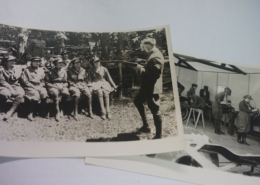Urban Archaeology: Evidence Emerges of Enslaved and Servant Home Life
by Director of Preservation Jessica Zullinger
Week two of excavations in and around the north garden “Tennis Lawn” at Tudor Place continues to produce remarkable archaeological findings. Last week, contractor Dovetail Cultural Resources uncovered what appeared to be the edge of a builder’s trench in one of the Orchard “units” (spade-dug pits). To follow up, Dovetail opened a second, adjacent unit to try to determine the trench’s size and extent.
What they discovered was not, in the end, a trench. At the level where they expected to find back-filled dirt in a narrow channel built to hold a foundation wall, the archaeologists instead found mounds of debris indicative of a domestic feature: Rather than a trench, they were digging in the feature itself, and coming across good-sized fragments of bone, ceramic sherds, buttons, a piece of pipe bowl, nails, and oyster shells, among other materials.
| Artifacts removed from the dwelling feature include rough, handmade pottery (left), ceramic sherds (center top) and buttons (lower left). |
The type and distribution of artifacts accords with what is typically associated with domestic dwellings inhabited by servants, and specifically enslaved servants. Equally exciting, from a reseearch perspective, are the nature of some of the ceramic sherds. These rough, hand-made pottery pieces suggest the type of vessels known to have been made by enslaved African Americans and primarily found in the Chesapeake and Carolina low-country regions. For Tudor Place, this remarkable discovery will be a huge step toward understanding and interpreting the lives of enslaved workers on this property and in nearby urban settings.
While this phase of archaeological investigation is coming to a close, we will continue to learn more about the project findings as the Dovetail team dates and analyzes the artifacts and their distribution pattern. Stay tuned to the blog for more details in the months to come!
| Soil removed from the unit and awaiting screening to separate artifacts from soil. Large pieces of bone and bits of shell are visible in the bucket. |




















